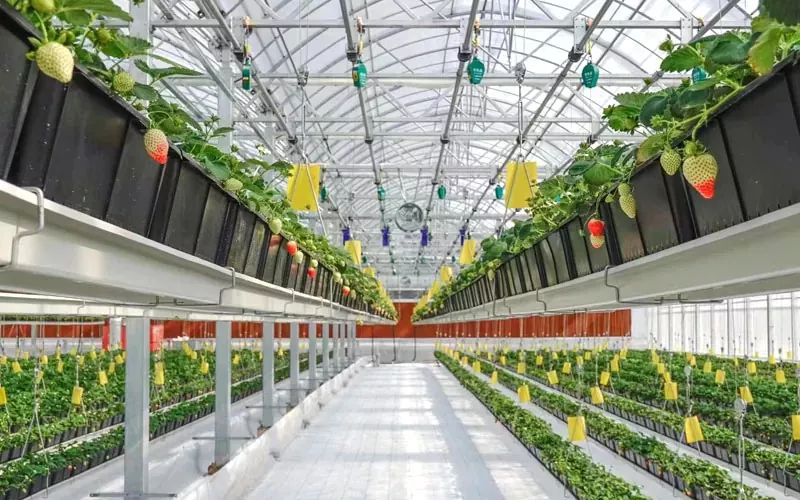Hot Dip Galvanized Steel Skeleton Greenhouse: A Durable Solution for Modern Farming
2025-02-24
In modern farming and agriculture, greenhouses have become essential structures for controlling growing environments, allowing plants to thrive in conditions that might otherwise be unsuitable. The materials used to build these greenhouses play a crucial role in their longevity, functionality, and resistance to environmental challenges. One of the most reliable options in greenhouse construction today is the hot dip galvanized steel skeleton greenhouse.
What is a Hot Dip Galvanized Steel Skeleton Greenhouse?
A hot dip galvanized steel skeleton greenhouse is a structure designed for agricultural use, where the frame (skeleton) is made from steel coated with a layer of zinc through a process known as hot-dip galvanization. This process involves immersing the steel into molten zinc, which forms a robust, corrosion-resistant coating on the metal. This coating helps the steel withstand harsh weather conditions, exposure to moisture, and other environmental stressors.
These greenhouses are popular because the steel skeleton offers strength and durability, while the galvanized coating provides long-lasting protection against rust and corrosion. As a result, they can last for decades, making them an excellent long-term investment for farmers and greenhouse operators.
Benefits of Hot Dip Galvanized Steel Skeleton Greenhouses
1. Durability and Longevity
The main advantage of using hot dip galvanized steel for greenhouse frames is its remarkable resistance to corrosion. Unlike traditional steel, which can rust and weaken over time, galvanized steel maintains its structural integrity even when exposed to rain, humidity, or soil conditions. This makes it a perfect material for greenhouses, which are often exposed to moisture and outdoor elements.
2. Cost-Effective
While the initial cost of hot dip galvanized steel may be higher than other materials, the long-term savings are significant. The reduced need for maintenance and repairs, as well as the longevity of the structure, ensure that this investment pays off over time. You’ll spend less on replacement parts or repainting, making it a cost-effective option for both small and large greenhouse projects.
3. High Strength
Galvanized steel has an excellent strength-to-weight ratio, meaning it provides exceptional stability and can support heavy loads without being overly bulky. This is crucial for maintaining the structural integrity of a greenhouse, particularly in regions that experience extreme weather conditions like strong winds or heavy snowfall.
4. Minimal Maintenance
Once galvanized, the steel is essentially maintenance-free. It does not require regular painting or special treatments to prevent rust, unlike non-galvanized steel structures that may need frequent maintenance to prevent corrosion. This ease of upkeep is a significant advantage for farmers who want to focus on their crops rather than worrying about the condition of their greenhouse.
5. Environmental Benefits
Zinc, the material used in galvanization, is a natural element that is abundant and recyclable. This makes galvanized steel a more environmentally friendly option compared to other materials that may have a larger environmental impact. Additionally, the extended lifespan of the greenhouse means fewer resources are required for replacements or repairs, reducing the overall carbon footprint of the operation.
6. Improved Plant Growth Conditions
The design and structure of hot dip galvanized steel skeleton greenhouses allow for optimal air circulation and light distribution, both of which are essential for healthy plant growth. The durability of the steel frame ensures that the structure remains stable even in harsh weather, which helps maintain the perfect growing environment for plants.
Applications and Usage
Hot dip galvanized steel skeleton greenhouses are ideal for a wide range of agricultural uses, from small-scale hobby farms to large commercial operations. They are particularly well-suited for regions that experience high humidity, heavy rainfall, or extreme weather conditions.
Some common applications include:
- Commercial crop production: Greenhouses built with hot dip galvanized steel can be used to grow a variety of crops, including vegetables, herbs, and flowers.
- Research and development: Agricultural research institutions use these greenhouses to study plant growth under controlled conditions.
- Urban farming: In cities, where space is limited, these greenhouses are a practical solution for growing food in an urban environment.
The hot dip galvanized steel skeleton greenhouse offers an excellent balance of strength, durability, and cost-efficiency. With its resistance to corrosion and low maintenance needs, it provides farmers with a reliable structure that ensures long-term productivity and optimal growing conditions for their plants. Whether you're a small-scale grower or a large commercial operation, investing in a hot dip galvanized steel greenhouse can provide you with a sturdy, sustainable solution that supports healthy plant growth and reduces overall maintenance costs.



